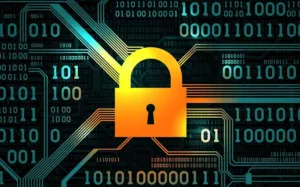Cybersecurity – In our modern, interconnected world, the digital realm has become an integral part of our daily lives. From online banking and social media to critical infrastructure and national security, our reliance on digital systems is undeniable. However, with this convenience and connectivity comes a growing risk – the ever-present threat of cyber attacks. Cybersecurity, once a niche concern, has now become a paramount issue that affects individuals, businesses, and nations alike.
The Cyber Battleground
Picture a vast digital landscape, a virtual frontier where information flows freely, and transactions occur in the blink of an eye. This is the realm of cyberspace, a domain that transcends physical boundaries and connects us all. However, lurking in the shadows of this digital world are malicious actors, seeking to exploit vulnerabilities and wreak havoc for personal gain or nefarious purposes.

These cyber threats come in many forms, from sophisticated nation-state actors engaging in cyber espionage to cyber criminal organizations executing ransomware attacks for financial gain. Even lone hackers, driven by curiosity or a misguided sense of challenge, can inadvertently cause significant harm.
The Evolving Threat Landscape
The cybersecurity landscape is constantly evolving, with new threats emerging at an alarming rate. From distributed denial-of-service (DDoS) attacks that overwhelm systems with traffic, to advanced persistent threats (APTs) that silently infiltrate networks and exfiltrate sensitive data, the tactics employed by cyber adversaries are becoming increasingly sophisticated.
One particularly concerning trend is the rise of ransomware attacks, where malicious software encrypts an organization’s data, rendering it inaccessible until a ransom is paid. These attacks have crippled businesses, hospitals, and even government agencies, causing massive disruptions and financial losses.
Protecting the Digital Frontier
In the face of these mounting cyber threats, robust cybersecurity measures are essential. Individuals, organizations, and governments must work together to fortify their digital defenses and stay ahead of the ever-changing threat landscape.

At the individual level, practicing good cyber hygiene is crucial. This includes using strong and unique passwords, keeping software up-to-date, and being wary of phishing attempts and suspicious online activity.
For businesses and organizations, implementing a comprehensive cybersecurity strategy is paramount. This strategy should encompass multiple layers of defense, including firewalls, intrusion detection and prevention systems, secure network architectures, and rigorous access controls.
Cybersecurity professionals play a vital role in this endeavor, working tirelessly to identify and mitigate vulnerabilities, respond to incidents, and implement robust security protocols. Their expertise is invaluable in safeguarding sensitive data, maintaining business continuity, and protecting critical infrastructure.
On a national level, governments must prioritize cybersecurity as a matter of national security. This includes fostering public-private partnerships, investing in cybersecurity research and development, and promoting cybersecurity education and awareness.
The Importance of Collaboration
Effective cybersecurity requires collaboration and information sharing across sectors and borders. By working together, organizations can leverage collective intelligence and resources to stay ahead of emerging threats. Initiatives like information sharing and analysis centers (ISACs) and computer emergency response teams (CERTs) facilitate the exchange of threat intelligence and best practices, enabling a coordinated response to cyber incidents.

Moreover, international cooperation and the development of global cybersecurity norms and regulations are crucial to ensuring a secure and stable cyberspace. Efforts such as the Paris Call for Trust and Security in Cyberspace, which promotes the peaceful use of cyberspace, are steps in the right direction.
Cybersecurity: A Shared Responsibility
In the digital age, cybersecurity is not just a concern for IT professionals or security experts; it is a shared responsibility that touches every aspect of our lives. From individuals protecting their personal information to businesses safeguarding their intellectual property and governments defending critical infrastructure, we all have a role to play in securing the digital frontier.
By fostering a culture of cybersecurity awareness and preparedness, we can mitigate the risks posed by cyber threats and ensure that the benefits of digital technology continue to enrich our lives while minimizing the potential for harm.
As we navigate the uncharted waters of the digital realm, let us remember that cybersecurity is not just about defending against attacks; it is about preserving the very fabric of our interconnected world. By working together, we can secure our digital frontier and pave the way for a safer, more resilient future.
READ ALSO
Quantum Computing – Unlocking Mysteries of the Subatomic World
Virtual Reality – Transcending Boundaries of Reality
Renewable Energy – Paving the way to a Sustainable Future
The Epic Journey to Conquer the Red Planet – The Journey to Mars
Frequently asked questions about cybersecurity
1. What is cybersecurity and why is it important?
Cybersecurity refers to the practice of protecting computer systems, networks, and digital information from unauthorized access, theft, or damage. It is important because our lives are increasingly reliant on digital technologies, and cyber threats can have severe consequences, including financial losses, data breaches, and disruptions to critical services.
2. What are some common types of cyber threats?
Common cyber threats include malware (such as viruses, worms, and ransomware), phishing attacks (attempts to trick users into revealing sensitive information), distributed denial-of-service (DDoS) attacks (overwhelming systems with traffic), and advanced persistent threats (APTs) (stealthy, targeted attacks often sponsored by nation-states).
3. What are some best practices for individuals to improve their cybersecurity?
Best practices for individuals include using strong and unique passwords, keeping software up-to-date, being cautious of phishing attempts, using two-factor authentication, and practicing good cyber hygiene. It’s also important to be mindful of what information is shared online and to use secure connections when handling sensitive data.
4. How can businesses and organizations enhance their cybersecurity posture?
Organizations should implement a comprehensive cybersecurity strategy, including firewalls, intrusion detection/prevention systems, secure network architectures, access controls, and employee training. Regular risk assessments, incident response planning, and data backup strategies are also crucial. Partnering with cybersecurity professionals and staying informed about emerging threats is essential.
5. What role do governments play in promoting cybersecurity?
Governments play a vital role in cybersecurity by investing in research and development, fostering public-private partnerships, promoting cybersecurity education and awareness, and developing cybersecurity policies and regulations. They also work to establish international norms and collaborate with other nations to address global cyber threats and ensure a secure and stable cyberspace.
References:
1. “Cybersecurity Essentials” by Charles J. Brooks (Wiley, 2021)
2. “Cybersecurity: A Beginner’s Guide” by Erdal Ozkaya (McGraw Hill, 2019)
3. “Cybersecurity for the Home and Office” by John Sammons (Course Technology, 2020)
4. “Cybersecurity and Cyberwar: What Everyone Needs to Know” by P.W. Singer and Allan Friedman (Oxford University Press, 2014)
5. “The Cybersecurity Dilemma: Hacking, Trust, and Fear Between Nations” by Ben Buchanan (Oxford University Press, 2017)
9. “Computer security, cybersecurity, digital security, or information technology security” Wikipedia
6. “Cybersecurity: A Primer for Policy Makers” by Dighton Fiddner and William Mendez (National Defense University Press, 2021)
7. “The Fifth Domain: Defending Our Country, Our Companies, and Ourselves in the Age of Cyber Threats” by Richard A. Clarke and Robert K. Knake (Penguin Books, 2020)
8. “The Cybersecurity to English Dictionary” by Kari Nissen and Mark Feddeman (Springer, 2019)

